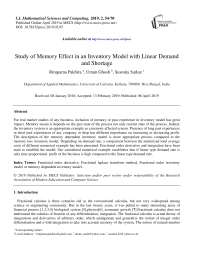Study of memory effect in an inventory model with linear demand and shortage
Автор: Rituparna Pakhira, Uttam Ghosh, Susmita Sarkar
Журнал: International Journal of Mathematical Sciences and Computing @ijmsc
Статья в выпуске: 2 vol.5, 2019 года.
Бесплатный доступ
For real market studies of any business, inclusion of memory or past experience in inventory model has great impact. Memory means it depends on the past state of the process not only current state of the process. Indeed, the inventory system is an appropriate example as a memory affected system. Presence of long past experiences or short past experiences of any company or shop has different importance on increasing or decreasing profit. The description of the memory dependent inventory model is more appropriate process compared to the memory less inventory model. Depending on demand rate, a comparison between the minimized total average costs of different numerical example has been presented. Fractional order derivative and integration have been used to establish the model. Our considered numerical example establishes that if linear type demand rate is only time proportional, profit of the business is high compared to the linear type demand rate.
Fractional order derivative, Fractional laplace transform method, Fractional order inventory model or memory dependent inventory model
Короткий адрес: https://sciup.org/15016693
IDR: 15016693 | DOI: 10.5815/ijmsc.2019.02.05
Список литературы Study of memory effect in an inventory model with linear demand and shortage
- Pakhira.R, Ghosh.U, Sarkar.S., “Study of Memory Effects in an Inventory Model Using Fractional Calculus”, Applied Mathematical Sciences, Vol. 12, no. 17, 797 – 824(2018).
- Pakhira.R., Ghosh.U., Sarkar.S., ”Application of Memory effects In an Inventory Model with Linear Demand and No shortage”, International Journal of Research in Advent Technology, Vol.6, No.8, (2018).
- Tarasova. V.V, TarasovV.E., “Memory effects in hereditary Keynesian model” , Problems of Modern Science and Education. No. 38 (80). P. 38–44. DOI: 10.20861/2304-2338-2016-80-001 [in Russian](2016).
- Tarasov. V.E, Tarasova.V.V., “Long and short memory in economics: fractional-order difference and differentiation” , IRA-International Journal of Management and Social Sciences. Vol. 5.No. 2. P. 327-334. DOI: 10.21013/jmss.v5.n2.p10,(2016).
- Saeedian.M, Khalighi.M, Azimi-Tafreshi, Jafari.N.G.R, Ausloos.M., “Memory effects on epidemic evolution: The susceptible-infected-recovered epidemic model”, Physical Review E95,022409, (2017).
- Das.T, Ghosh.U, Sarkar.S and Das.S.,“Time independent fractional Schrodinger equation for generalized Mie-type potential in higher dimension framed with Jumarie type fractional derivative”, Journal of Mathematical Physics,59, 022111 ,doi: 10.1063/1.4999262,(2018).
- Tarasova.V.V, Tarasov.V.E,” Logistic map with memory from economic model”, Chaos, Solitons and Fractals, Vol. 95. P. 84-91. DOI: 10.1016,j.chaos.2016.12.012, (2017).
- Das. S., Functional Fractional Calculus 2ndEdition, Springer-Verlag, (2011).
- Podubly.I., “Fractional Differential Equations”, Mathematics in Science and Engineering, Academic Press, San Diego, Calif, USA.198(1999).
- Miller.K.S, Ross.B., “An Introduction to the Fractional Calculus and Fractional Differential Equations”. John Wiley &Sons, New York, NY, USA, (1993).
- Caputo.M., “Linear models of dissipation whose frequency independent”, Geophysical Journal of the Royal Astronomical Society. 13(5), 529-539,(1967).
- Tarasov. V.E., TarasovaV.V., “Economic interpretation of fractional derivatives”, Progress in Fractional Differential and Applications.3.No.1, 1-6,(2017).
- Podlubny.I., “Geometric and physical interpretations of fractional integral and fractional differentiation”, An international Journal of Theory and Application, Volume 5, Number4, ISSN1311-0454, (2002).
- Jumarie.G., “Modified Riemann-Liouville derivative and fractional Taylor series of non-differentiable functions further results”, Computers and Mathematics with applications, (51) 1367-1376; (2006).
- Mittag-Leffler, G. m. Sur lanouvelle function E a(x), C.R.Acad.sci. Paris, (Ser.II)137, 554-558, (1903).
- Diethelm. K, The analysis of Fractional Differential equations. Springer-Verlag, (2010).
- Silver.E.A and Meal.HC., A Simple modification of the EOQ for the case a varying demand rate. Production of Inventory Management, 10:52-65,(1969).
- Donaldson.W.A., Inventory replenishment policy for a linear trend in demand –an analytical solution, Operation Research Quarterly.28:663-670,(1977).
- McDonald.J.J., “Inventory replenishment policies-computational solutions”, Journal of the operation Research Quarterly; 30(10):933-936,(1979).
- Ritchie.E.,The optimal EOQ for linear increasing demand- a Simple optimal Solution. Journal of the Operational Research Society, 35:949-952, (1984).
- Sachan.R.S., “On(T,Si) inventory policy for deteriorating items with time proportional demand”. Journal of the Operational Research Society, 35:1013-1019, (1984).
- Silver.E.A., “A Simple inventory replenishment decision rule for a linear trend in demand”. Journal of the Operational Research Society.30:71-75.
- Ghosh.U, Sengupta.S, Sarkar.S, Das.S, “Analytic Solution of linear fractional differential equation with Jumarie derivative in term of Mittag-Leffler function”, American Journal of Mathematical Analysis, 3(2).32-38, (2015).
- A.K. Das and T.K.Roy,Role of fractional calculus to the generalized inventory model,” Journal of global Research in computer science,Vol-5;No.2; pp. 11-23, (2014).


